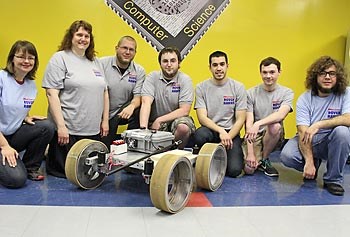Event Was Held at Johnson Space Center in Houston

Members of the 2013 Rover Hawks include, from left, Brigit Schroeder, Prof. Holly Yanco, James Dalphond, Eric McCann and undergraduate students Alejandro Salido, Adam DeFelice and Carlos Ibarra.
06/11/2013
By Edwin L. Aguirre
A team of UMass Lowell robotics undergraduate and graduate students, called the “Rover Hawks,” beat seven other teams from nine universities from across the country to take home the top prize in an engineering contest sponsored by NASA and organized by the National Institute of Aerospace.
Called the RASC-AL Exploration Robo-Ops Competition, or “Robo-Ops,” the event challenged the teams to build planetary rover prototypes and to demonstrate their capabilities by performing a series of competitive tasks in a Mars-like environment. The field tests were conducted June 4-6 at the NASA Johnson Space Center’s Rock Yard in Houston. Each team received $10,000 to cover expenses for the rover’s hardware and software development, materials and testing.
“We came in first place in the competition with our student-built and programmed rover, unseating Worcester Polytechnic Institute from the first-place berth they had held for the past two years in our first year participating in the event,” says computer science Prof. Holly Yanco, who is the team’s faculty adviser and director of UMass Lowell’s Robotics Lab. “The University of Maryland took second place, and WPI third.”
Other contestants included Arizona State University; the Florida Agricultural and Mechanical University/Florida State University; the University of Nebraska, Lincoln; the University of Utah and West Virginia University/Bluefield State College.
A Robotic Rockhound
“We are thrilled at this opportunity for the University to get its name out there with NASA and the robotics world,” says James Dalphond, a Ph.D. candidate in computer science and the Rover Hawks team leader. “We have been doing great things in robotics over the years but I think this NASA competition will bring more attention to the work we are doing.”
“This is the first time we competed in Robo-Ops so we’re all fired up,” says Eric McCann, who received his master’s degree in computer science in May and has led the rover’s software development.
The team’s four-wheeled, suitcase-size rover measures 36 inches long, 32 inches wide and 19 inches tall. It tips the scale at 76 pounds, including its 12-volt lithium-ion batteries.
“The rover is equipped with four cameras — facing forward, backward, at the arm and at the wheels so we can see if we are caught on anything,” explains Dalphond. “It also has a laptop computer optimized to be powerful yet able to run efficiently on batteries, as well as a manipulator arm and gripper. The arm is capable of reaching anywhere in front of the robot to pick up rocks and then store them in a container on the rover itself.”
What makes the Rover Hawks rover unique?
“First, I think it is because of its overall low cost,” says Dalphond. “Although we have spent our entire budget on developing the rover, its actual cost is only about $8,500,” says Dalphond. “In comparison, I have seen other rover teams spend more than $10,000 just to fabricate the machined parts.”
He adds: “Second, I would say our rover is special because it was designed and built largely as an undergraduate class project. Twenty students were given the opportunity to provide input on the robot’s design as well as to write the control/network software required to run it.”
Mission Control in Lowell
Yanco, Dalphond, McCann and Brigit Schroeder, a computer science graduate student who helped develop the rover’s computer vision, were in Houston to test the vehicle on-site prior to the competition.
The rest of the team stayed behind at UMass Lowell’s NERVE Center, which served as the Rover Hawks “mission control” where video feed from the rover’s cameras was streamed live. The rover’s “driver” was required to control the vehicle remotely using a commercial 4G cellular connection. The rover successfully negotiated a series of obstacles while performing a variety of tasks, including traversing slopes and sand and gravel pits, picking up specific rock samples and placing them on the rover’s onboard container and driving over rocks of specified size.
You can read the team’s blog at http://www.roverhawks.blogspot.com/. You can also watch the rover in action in this YouTube video.
